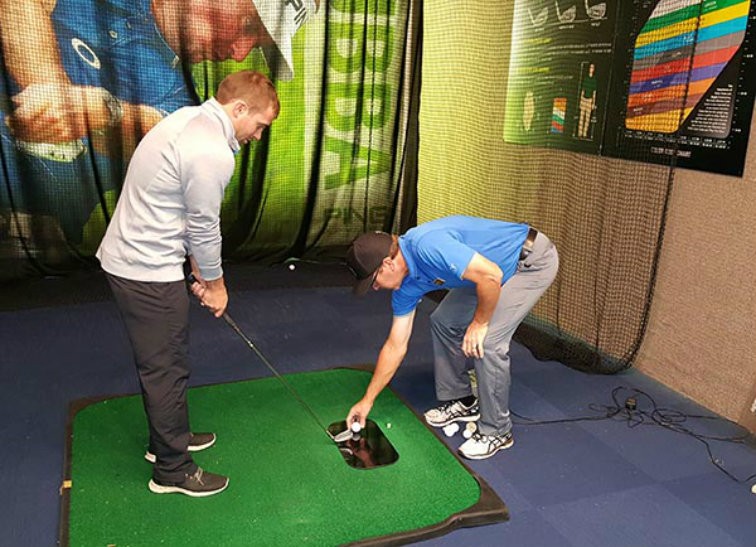Many golfers, even avid golfers who compete often at their local club, spend little time picking out their golf clubs. In fact, they may spend more time choosing their golf apparel than their sticks.
“In any other sport or athletic activity, before you play, you make sure that your equipment fits your needs so that you can perform to the best of your ability,” says Tim Sygerych, Master Club Fitter at Westhaven Golf Club in Franklin.
“But in golf, the equipment is always overlooked for whatever reason. You just go to the store and pick up any old set and head to the course. When you don’t play well, you blame yourself, using some of the age-old lines like ‘I’m not very good,’ or ‘I wasn’t swinging well today,’” adds Sygerych. “Truth is, the equipment you were using was most likely incorrect for you. Your swing is more consistent than you allow yourself to believe and ill-fitted equipment cause more problems and bad shots.”
Sygerych’s theory is that by getting fitted for clubs, you take the equipment out of the equation. You can improve your game either through lessons or natural ability and feel confident that you are using the correct clubs. Being properly fitted for clubs is not reserved solely for professional golf players. It can be for any player who plays the game of golf.
5 Steps to A Proper Club Fitting
1. GRIP & GRIP SIZE
First, Sygerych says he measures the golfer’s overall hand size – from their palm to the tip of their middle finger because it’s the longest finger on the hand . “The grip is the only part of the club you can control. If your grips are too small or too big, your hands will slip or ‘regrip’ at some point during your swing. This will cause you to miss hit the ball,” he explains. ”Also, a grip that is too small or too big, will cause you to have tension in your forearms, causing stress, and robs a player potential distance and results in poor directional control.”
Once Sygerych gives the golfer his grip size, the player chooses the actual grip he or she likes best, based on feel, looks and manufacturer. Some grips have a rougher feel while others are more smooth. Sygerych says there are about 30 choices of grips from manufacturers like Golf Pride, Lamkin and Winn.
Sygerych warns that each club should have the same grip on it. “With each different grip, your hands send a message to your brain, and when it feels something different, the brain recognizes this and sends a negative message to the rest of the body and goes into defense mode,” he says. “You may not consciously notice it, but it is happening. People ask all the time how they can become more consistent as golfers. It starts with having your grips the same style and having the same size.”
2. CLUB LENGTH
In order to determine the length of your clubs, Sygerych must determine your standard, or static measurement. He does this by measuring from the ground to the middle knuckle of the golfer’s non-dominant hand while standing. “This gives the length of what the clubs need to be,” he says.
3. SHAFT FLEX
“I take the club length measurement and apply it to a series of golf clubs,” says Sygerych. “That length will tell us that we have the proper posture and set-up at address position (i.e. addressing the ball).”
At this point the golfer will hit some balls using clubs that are the same length but with different shaft flex’s. Shafts have some elasticity or give to them – some more than others.
“Shaft flex is another part of the club that controls the direction of the golf ball. If your clubs are too weak, chances are the ball will go all over the map, with no consistence. One time it will go 20 yards to the left and the next shot will go 20 yards to the right,” he explains. “On the other hand, you may hit your clubs straight as an arrow a majority of the time, but feel that you don’t get the distance you should be getting. This is a sign that your shafts are too stiff for you.”
The player will hit golf balls indoors using a Trackman (Doppler radar that measures the flight of the golf ball from impact to landing). The data that Sygerych collects will determine the proper shaft flex for that golfer.
4. LIE ANGLE
The relationship between the shaft and the ground is called the lie angle, and the lie angle controls the direction of the ball. The goal is to make sure the golfer is hitting the ball on the sweet spot – or center—of the club head. “Properly fit lie angles should allow you to hit the ball straight, given all other variables are working properly. If you are hitting the ball fat and to the left, chances are your clubs are too upright for you. On the other hand, if you are hitting the ball thin and off the toe of the club, then your clubs are too flat.”
5. CLUB MANUFACTURER
Sygerych then provides the golfer with the brands of clubs that can be built to his specifications. The player then hits balls using those clubs to determine which manufacturer he likes best. “That’s based on looks and feel. It’s a process of elimination,” says Sygerych. There are seven manufacturers Sygerych uses: Titleist, Callaway, Mizuno, Taylor Made, Muria, PXG and Ping.
Once the clubs are ordered and then delivered, Sygerych checks each one to ensure they have been made to the correct  specifications before the player picks them up.
specifications before the player picks them up.
Tim Sygerych can be reached at Westhaven Golf Club, by phone 615-224-2983 or email, [email protected].
Learn more about the Westhaven Golf Club at golfwesthaven.com.



















